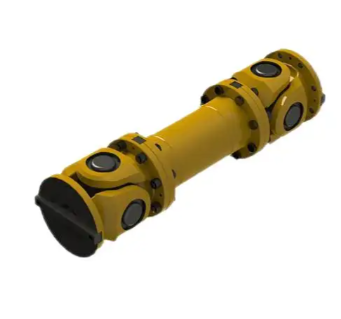Definition and Core Functionality of Flexible Couplings
Transmitting Torque Between Shafts
Flexible couplings play a key role in machinery where they transmit torque between shafts while allowing some movement between them. What makes them so important? They connect shafts but also handle those inevitable small misalignments that happen in real world installations. When properly installed, these couplings absorb shocks during operation, protecting bearings and other parts from premature failure. Industry experience shows machines with good quality couplings last longer because they maintain consistent power transfer without stressing components unnecessarily. Selecting the correct coupling type matters a lot since different applications have varying demands for alignment tolerance and shock absorption capabilities.
Accommodating Angular and Parallel Misalignment
Flexible couplings offer something really important when it comes to handling misalignment issues between shafts. They work well with both angular and parallel misalignment situations. This feature helps keep systems running efficiently while also safeguarding other parts of the drive train. When these couplings handle misalignment properly, they take some of the strain off mechanical systems, cutting down on unexpected breakdowns and saving money on repairs over time. Engineering studies point out that without proper alignment, machines tend to vibrate more and make louder noises, which eventually affects how well they perform overall. So in practical terms, flexible couplings play a big part in keeping machinery operating at its best by reducing those pesky alignment problems that plague so many industrial setups.
Key Components and Working Mechanism
Hub and Elastomeric Elements
When talking about flexible coupling tech, nobody can ignore the importance of the hub. Basically, it connects the coupling to those metal shafts we all know so well. Most hubs come with special designs that make attaching them to different sized shafts pretty straightforward. This kind of versatility matters a lot when dealing with all sorts of industrial setups where getting that perfect fit makes power transfer work better. The hubs usually work hand in hand with these rubbery parts called elastomers. These components give the whole system its needed flexibility. They soak up vibrations from running machines and handle small alignment issues between shafts, which helps protect equipment from unnecessary damage over time. We've seen some interesting developments lately in what materials go into making these elastomers. Newer versions last longer and perform better under stress, meaning manufacturers now get coupling systems that stand up to tough conditions while still moving power efficiently through the machinery.
Compensating for Shaft Displacement via Flexibility
Flexible couplings handle those little angular shifts, radial movements, and axial displacements that happen all the time in machinery operations. When machines run, they tend to move around a bit, and without proper coupling solutions, this can lead to serious problems like excessive stress on components or shaft misalignment issues that plague many factories daily. The real value comes from how these couplings absorb those movements, cutting down on breakdowns while making sure everything runs safer and lasts longer. Industry reports show plants using good quality flexible couplings report significantly fewer shutdowns compared to those without them. Fewer unexpected stops means better productivity across the board, which explains why most manufacturing facilities now consider flexible couplings essential parts of their maintenance strategy.
Types of Flexible
Elastomeric Couplings (Vibration Damping)
Made from rubber-like substances, elastomeric couplings excel at dampening vibrations which makes them indispensable in settings sensitive to shaking movements. They cut down on noise levels while protecting components from premature wear, leading to smoother running machines in industrial environments. The reduction in vibration damage means equipment runs better for longer periods without breakdowns. Mechanical engineers have found that these couplings boost how well machines operate day after day, plus they help equipment last years longer because they soak up both vibrations and alignment issues. For this reason, many manufacturers rely on them whenever their systems need serious vibration control, especially in precision manufacturing lines and heavy duty production facilities.
Metallic Couplings (High-Torque Applications)
Metallic couplings work really well in situations where there's a lot of torque because they're built tough enough to handle serious stress without bending out of shape. They tend to last much longer than rubber-based options when put through their paces in harsh industrial settings. Most factories that run heavy equipment report better results when switching to metal couplings, especially when dealing with those intense load scenarios common in manufacturing plants. The extra strength these components offer explains why so many plant managers reach for metallic couplings first whenever durability matters most in their operations.
Universal Joints for Complex Misalignment
Universal joints belong to the family of flexible couplings but they're specifically built to handle those tricky misalignment situations that other components just can't manage. What makes them stand out is how they bend and twist while still transmitting power efficiently between shafts that aren't perfectly aligned in straight lines. We see these joints all over the place in cars and heavy machinery because real world applications rarely give us perfectly straight alignment conditions. Mechanics and engineers who work on vehicle drivetrains will tell anyone that without proper universal joints, things start falling apart pretty quickly. The real magic happens when these joints accommodate different angles of misalignment without losing their grip on performance standards. This means fewer breakdowns and less downtime for machines operating under constantly changing conditions.
Common Applications in Modern Machinery
Industrial Power Transmission Systems
Flexible couplings are essential components in industrial power transmission setups because they help transfer torque better while handling those pesky alignment problems that happen all the time. Most factories install them on stuff like conveyor belts, water pumps, and big construction gear. These couplings really cut down on wasted energy and prevent breakdowns that cost money. Plants that have switched to flexible couplings tend to see way fewer interruptions during production runs. Take automotive manufacturing for instance many assembly lines now run almost non-stop thanks to these parts keeping everything connected properly. The result? Less downtime means more product coming off the line day after day.
Automotive and Precision Equipment
Flexible couplings play a key role in cars by keeping connections stable even as engines move around, all while sending power where it needs to go across different parts of the vehicle. These same couplings show up in things like robotics and industrial machinery too, giving manufacturers better control over their machines when precision matters most. According to recent industry reports, carmakers who invest in newer coupling tech tend to see improvements in both how well their vehicles perform and how long they last before needing repairs. The ability to handle movement without breaking down means these components stay functional longer, which makes sense for automakers trying to stand out from competitors in today's tough market.
Selection Criteria and Best Practices
Evaluating Torque and Speed Requirements
Picking the right flexible coupling for any given application means looking closely at torque and speed requirements first. The whole point is making sure everything works together properly without causing problems down the road. What engineers need to know includes the highest torque levels the coupling can handle plus what kind of speeds the system will actually run at during normal operation. Skip over these basics and watch out for trouble. We've seen too many cases where couplings simply snap under stress because someone didn't do their homework on specs. Mechanical designers consistently emphasize that taking time to check torque and speed specs does more than just stop breakdowns. It actually makes machines perform better over longer periods too. Getting this right from the start means the coupling can truly meet what the system needs day after day, cutting down those frustrating unplanned shutdowns that nobody wants.
Environmental Factors and Maintenance Considerations
The environment plays a big role when picking out flexible couplings because things like heat levels, moisture content, and chemicals in the air really affect how they work over time. Take temperature extremes for example - too hot or too cold can warp materials, which messes up alignment problems down the road. That means finding couplings built to handle whatever conditions they'll face is pretty important if we want them lasting longer without breaking down early. Keeping these components well maintained makes all the difference during their working life. Most manufacturers actually offer detailed manuals about proper care routines including regular inspections and tweaks as needed. Following this advice keeps everything running smoothly while making those couplings last much longer than expected, cutting down on unexpected breakdowns and replacement costs.
FAQs
What are flexible couplings used for?
Flexible couplings are used to transmit torque between shafts in machinery, accommodating minor misalignments and providing smooth power transmission.
How do flexible couplings reduce wear and tear on machinery?
Flexible couplings reduce wear and tear by absorbing shock loads and accommodating misalignments, which decreases stress on connected components.
What types of flexible couplings are available?
Common types include elastomeric couplings for vibration damping, metallic couplings for high-torque applications, and universal joints for managing complex misalignments.
How can flexible couplings enhance the longevity of machinery?
By effectively transmitting torque and accommodating misalignments, flexible couplings can enhance machinery longevity and reliability.
What should be considered when selecting flexible couplings?
Considerations include evaluating torque and speed requirements, environmental factors like temperature and humidity, and planned maintenance procedures.

